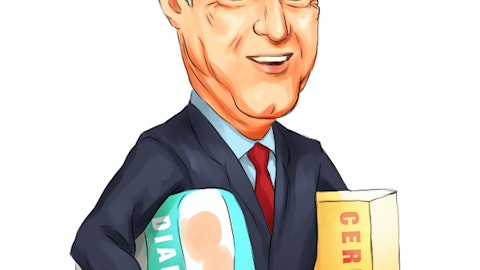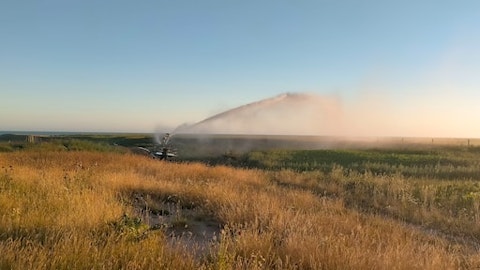Nathan Jones: Obviously, some issues in Argentina. What’s the relative size for you guys between Brazil and Argentina? Is Brazil significantly bigger?
Randy Wood: We haven’t broken that out specifically, Nathan, but your instinct is correct. Brazil would be significantly more impactful to us than Argentina in terms of market size.
Nathan Jones: Got it. And then I just wanted to go back to the domestic business. I thought that growth year-over-year in the first quarter was pretty encouraging. Crop prices have been on the decline through 2023, which all else equal, would suggest that farm income will be lower in ’24 than it was in ’23. There’s obviously the most tested with that with crop inputs and financing costs and all those kinds of things. Is it reasonable to think that you know farm income is down in ’24 and that should probably lead to domestic irrigation down in 2024? Or is that no way you’re thinking about it at this point?
Randy Wood: I think at a macro level, obviously, I think your logic walks based on history, Nathan. I think the anomaly this coming year in 2024, if you think back to where we were Q2, Q3 of last year, we talked a lot about customers taking that wait-and-see approach that they were waiting for interest rates to come down, waiting for inflation to stabilize, waiting for pivot prices to come down. Right now, we see a lot more stability. So just the fact that we think we’ll — we won’t see that — those delayed purchase decisions. Just a more normalized seasonal order pattern next year will offset some of that market softness and maybe some of those end-of-year machines and first quarter machines that we saw this year we’re going to see that more naturally in the second and third quarter next year.
But I think it will be difficult to predict some significant upside in the market just because those fundamentals related to farm income and crop prices and their impact on customer sentiment. It’d be tough to see line of sight to significant growth. But I think, again, with the comps that we have, particularly year-over-year for Q2 and Q3, we don’t see the market falling apart either. And farmers are profitable. They invest.
Nathan Jones: Yeah, thanks. I’ll pass it on.
Operator: Thank you. The next question comes from Brian Wright with ROTH MKM. Please go ahead.
Brian Wright: Thanks. Good morning and thanks for the question. Just wanted one more on the Brazil situation. Given the dryness in Mato Grosso and hearing that it could be a game still a game time decision come February and March for the Safrinha season as far as Plan A sectors. Is that like should we be thinking about that as a positive backdrop as far as potential and why your commentary on the strong kind of quoting levels that you’re seeing?
Randy Wood: I think the weather there and that’s going to be obviously the biggest market for that Safrinha second season crop. And if there is some risk to germinating a crop, maturing a crop, irrigation obviously is going to offset some of that risk. So we would view that as a potential tailwind to the continued market opportunity in Brazil. But as Brian mentioned earlier, it’s going to be about access to capital. And do they — have they sold the first crop given them the cash flow they need to go into the second and potentially the third crops in some parts of the country. So there’s certainly some good macro tailwind there, but they still have to get access to funding. And again the FINAME program is going to be supportive. We’re seeing the central bank rate continue to drop, and that’s going to be supportive of financing. So we do see that as some potential upside.
Brian Wright: Okay. Thank you. And then I guess a follow-up there has been talk in Brazil about putting together an incentive program to — for the conversion of pastureland to cropland. Just is there kind of any headwind or headway that’s been made on a regulatory or legislative front on that in the past quarter or two?
Randy Wood: In our view not a lot that would be actionable in the near term.
Brian Wright: Okay. Okay. Great. And then just a real quick balance sheet question. Marketable securities were up pretty nicely sequentially you know up to over $10 million in the quarter. Just what kind of securities are you buying there?
Brian Ketcham: These would be high-grade commercial paper and other things where, and generally, it’s going to be beyond 90 days, but six month maturities or so. But an opportunity to get some additional rates interest income. So it’s just a little bit of an allocation of cash from compared to where we were at the end of the calendar year.
Brian Wright: Okay. Great. And then I guess one last one, if I could. Inventory picked up a bit sequentially in the quarter. Just thoughts on that?
Brian Ketcham: I would say it’s mostly going to be a seasonal kind of a thing as we get into the main selling season in North America. That’s probably the biggest driver of the increase. And if you go back to 2023, over the course of the year, we reduced overall inventories about $40 million. So a slight uptick in the first quarter is really more of the seasonal nature of the business.
Brian Wright: Okay. Great. That bodes well for North America in next quarter. So that’s great. That’s all I’ve got. Thank you so much for the questions.
Brian Ketcham: Thanks, Brian.
Operator: Thank you. [Operator Instructions] The next question comes from Jon Braatz with Kansas City Capital. Please go ahead.
Jon Braatz: Good morning, Randy and Brian.
Randy Wood: Good morning, Jon.
Brian Ketcham: Good morning, Jon.





